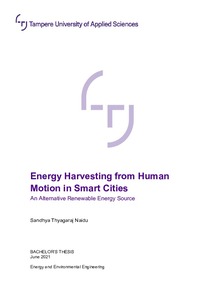Energy harvesting from human motion in smart cities : an alternative renewable energy source
Thyagaraj Naidu, Sandhya (2021)
Thyagaraj Naidu, Sandhya
2021
All rights reserved. This publication is copyrighted. You may download, display and print it for Your own personal use. Commercial use is prohibited.
Julkaisun pysyvä osoite on
https://urn.fi/URN:NBN:fi:amk-2021060815205
https://urn.fi/URN:NBN:fi:amk-2021060815205
Tiivistelmä
The purpose of the thesis was to study human motion-based energy harvesting through the literature review resulting in integrating as a renewable energy source within a smart city. The study aimed to examine equipment and applications in the market to convert human motion into energy and find locations to install within a smart city. Energy harvesting from human motion is a renewable and sustainable energy source. Human energy harvesting technology converts kinetic energy from human body movements to electricity. The smart city is a concept to define an urban area using information and communication technology as a solution to solve the city's human, social, economic, and environmental issues.
The theoretical framework was to examine energy harvesting from human motion and the smart city concepts. It includes identified everyday common human activities examples and human motion-based energy harvesting types of equipment in the market. It also covers the need for a smart city, the smart city framework program, and smart energy management initiatives. A literature review identified kids playground energy equipment in public parks, fitness energy equipment in gyms, and human walking flooring equipment in crowded areas to incorporate into a smart city. Besides, a modified cost-benefit analysis was designed and applied to assess the proposed energy harvesting solutions from human motions. It includes the evaluation of financial analysis parameters. The Financial analysis was quantitatively evaluated by computing expenditure costs, electricity generated, and revenues.
The empirical study results indicate environmental reduction costs were zero, integrating costs were minimal, implementation and environmental risks are low but lesser revenues, and investment payback durations will be high. Energy harvesting from human energy fits with the concept of smart cities because it uses urban problems with high human populations to tackle energy shortages while still meeting smart energy initiatives. Therefore, deploying a human motion-based energy harvesting source is a feasible option comparable to existing renewable energy alternatives in terms of environmental, indirect social, and economic benefits in the framework of a smart city.
The theoretical framework was to examine energy harvesting from human motion and the smart city concepts. It includes identified everyday common human activities examples and human motion-based energy harvesting types of equipment in the market. It also covers the need for a smart city, the smart city framework program, and smart energy management initiatives. A literature review identified kids playground energy equipment in public parks, fitness energy equipment in gyms, and human walking flooring equipment in crowded areas to incorporate into a smart city. Besides, a modified cost-benefit analysis was designed and applied to assess the proposed energy harvesting solutions from human motions. It includes the evaluation of financial analysis parameters. The Financial analysis was quantitatively evaluated by computing expenditure costs, electricity generated, and revenues.
The empirical study results indicate environmental reduction costs were zero, integrating costs were minimal, implementation and environmental risks are low but lesser revenues, and investment payback durations will be high. Energy harvesting from human energy fits with the concept of smart cities because it uses urban problems with high human populations to tackle energy shortages while still meeting smart energy initiatives. Therefore, deploying a human motion-based energy harvesting source is a feasible option comparable to existing renewable energy alternatives in terms of environmental, indirect social, and economic benefits in the framework of a smart city.
Kokoelmat
Samankaltainen aineisto
Näytetään aineisto, joilla on samankaltaisia nimekkeitä, tekijöitä tai asiasanoja.
-
Renewable energy resources and energy storage solutions : gravity batteries as an innovative way of store energy
Pavlova, Daria (2024)The subject of the thesis was the research of modern renewable energy sources and methods of its storage. The thesis was conducted as a part of the storage system project and aimed to explore the possibility of creation ...Rajoitettu käyttöoikeus / Restricted access / Tillgången begränsad -
Solar energy availability at case-specific geographical locations : comparing household energy usage to available solar energy supply
Henilans, Daniels (2024)This thesis explores the potential of using solar energy to power households entirely in regions near polar latitudes, with a focus on case studies in Latvia and Finland. By analyzing the energy consumption patterns of ... -
Battery energy storage system (BESS) in the energy system optimization : A Flexible Energy System Integration and Optimization (FESIO) Project Report
Koskinen, Ossi; Saarikoski, Lotta; Chukwuka, Chisom
Vaasan ammattikorkeakoulu, University of Applied Sciences publications : Research reports : 4 (Vaasan ammattikorkeakoulu, 2025)


